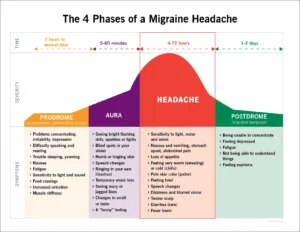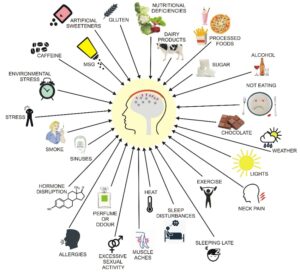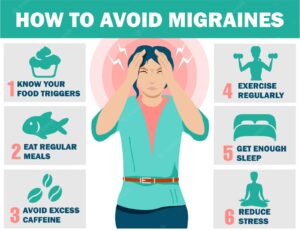Why you feel sharp throbbing pain in only one side of your head?
What is migraine?
A migraine is usually a headache from moderate to severe felt as sharp throbbing pain on only one side of the head . The pain is not uniform , the pattern and intensity varies from person to person . It may accompanied by nausea vomiting sensitivity to the light sound and smell. It last from hours to days and interfere in your normal daily life activities.
TYPES OF MIGRAINES:
There are different types of migraine, but not everyone will have ‘typical’ migraine.
Types of migraine are:
Migraine with aura:
Where there are some specific warning signs just before the migraine begins, like visual disturbances, such as flashes of light or blind spots, or other disturbances, such as tingling on one side of the face or in an arm or leg and difficulty speaking.
Auras can either happen on their own or together with the symptoms of a migraine without aura. The auras usually happen before a headache, which could be severe or mild. In some people the headache may not happen.
Aura symptoms can include:
- numbness or tingling sensation like pins and needles in parts of your body.
- Muscle weakness
Feeling dizzy or off balance.
Migraine without aura:
Migraine without aura is the most common type of migraine.
‘Aura’ is a warning sign of a migraine. It is most commonly a symptom that affects your sight, such as blind spots or seeing flashing lights. If you have migraine without aura, you won’t get a warning sign that a migraine attack is about to start.
Chronic migraine:
Chronic migraine is defined as having headache on at least 15 days per month, with eight of these having migraine symptoms, for at least three months. People who have fewer headache days with migraine symptoms have episodic migraine.
chronic migraine symptoms may include:
- frequent headache
- Increased sensitivity to light, sound or smells
- nausea (feeling sick)
- vomiting (being sick).
Menstrual migraine:
Migraine that occur during the menstrual cycle or women going through the hormonal changes (periods). This is most commonly occur in women than in men.
migraine aura without headache:
It is also known as silent migraine. where an aura or other migraine symptoms are experienced, but a headache does not develop. Some people have migraines frequently, up to several times a week. Other people only have a migraine occasionally.

SYMPTOMS:
Migraines, which affect children and teenagers as well as adults, can progress through four stages: prodrome, aura, attack and post-drome.
Prodrome phase:
It is the first phase of migraine and also known as premonitory phase or headache. It is a sign that headache is about to start. It remains for few hours to days. It may include:
- Irritability
- Depression
- Increased urination
- Sensitivity to light and sound
- Muscle stiffness
- Difficulty in speaking and reading.
Aura:
Auras are reversible symptoms of the nervous system.
Examples of migraine aura may include:
- Visual phenomena, such as seeing various shapes, bright spots or flashes of light
- Vision loss
- Pins and needles sensations in an arm or leg
- Weakness or numbness in the face or one side of the body
- Difficulty speaking
Headache:
After a prodrome and aura phase person will feel sharp throbbing and severe headache in one side of head. A migraine usually lasts from 4 to 72 hours if untreated.
During a migraine, you might have:
- Pain usually on one side of your head, but often on both sides
- Pain that throbs or pulses
- Sensitivity to light, sound, and sometimes smell and touch.
- Nausea and vomiting.
Postdrome phase:
It is also called migraine hangover, comes after the migraine attack has subsided.
It may include:
- Inability to concentrate
- Fatigue
- Depressed mood
- Lack of concentration.
WHEN TO GET A MEDICAL ADVICE:
Simple painkillers, such as paracetamol are effective for migraine. But try not to use the maximum dosage of painkillers on a regular or frequent basis as this could make it harder to treat headaches over time. If you are having a migraine frequently in less than 5 days, you should go to the doctor and ask for medical advice.
WHAT SHOULD YOU DO IF YOU SEE SOME ONE IS HAVING SEVERE MIGRAINE AND GETTING WORST?
If you see some one is having migraine and it’s getting only worst than you should 1st give him painkiller and immediately call a doctor. Because worsening the condition may cause the paralysis, grabbed speech ,fever, neck stiffness, mental disturbance, stroke and seizures.
Migraine triggers by:
Hormonal changes in women:
During the periods or having a pregnancy can some time trigger a migraine.
Drinks:
These include alcohol, especially wine, and too much caffeine, such as coffee.
Stress:
Stress at work or home can cause migraines.
Sensory stimuli:
Bright or flashing lights can induce migraines, as can loud sounds. Strong smells such as perfume, paint thinner, and others trigger migraines in some people.
Sleep changes:
Missing sleep or getting too much sleep can trigger migraines in some people.
Foods:
Aged cheeses and salty and processed foods might trigger migraines. So might skipping meals.

Treating migraine:
There’s no cure for migraines, but a number of treatments are available to help reduce the symptoms which may include:
- painkillers – including over-the-counter medicines like paracetamol.
- Triptans – medicines that can help reverse the changes in the brain that may cause migraines.
- Anti-depressants.
- Anti-seizure drugs.
- During an attack, many people find that sleeping or lying in a darkened room can also help.
Preventing migraines:
If you note that some specific things causing your migraines, such as stress or a certain type of food, avoiding this may help you to reduce risk of having migraines.
It may also help to maintain a generally healthy lifestyle, including regular exercise, sleep and meals, as well as ensuring you stay well hydrated and limiting your intake of caffeine and alcohol.

Author


